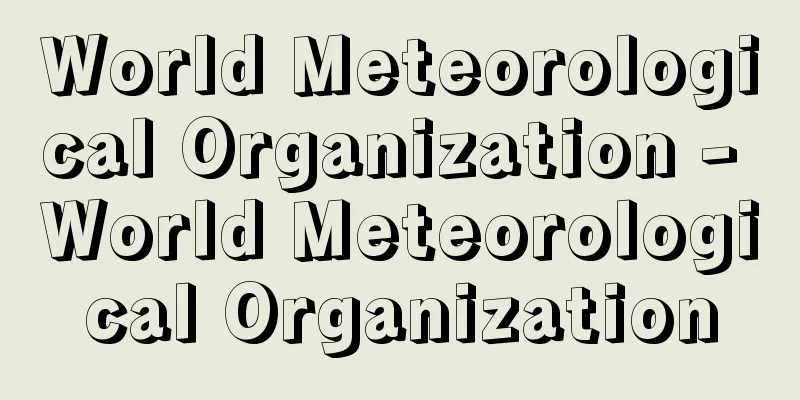World Meteorological Organization - World Meteorological Organization

|
One of the specialized agencies of the United Nations. Abbreviated as WMO. As of 2011, 183 countries and 6 territories are members. As weather has no borders, international cooperation is essential for meteorological observation operations. The seeds of WMO date back to the Maritime Meteorological Congress held in Brussels, Belgium in 1853, and the subsequent International Meteorological Congress held in Vienna, Austria in 1873 was the beginning of IMO (International Meteorological Organization), the predecessor of WMO. The WMO Convention came into force in 1950, and Japan joined in 1953 (Showa 28). The objectives of WMO are: The WMO's highest decision-making body is the World Meteorological Congress, which meets once every four years, and it has an Executive Council, technical committees, regional meteorological associations, and a secretariat. Its main activities include the World Weather Watch (WWW), the World Climate Programme (WCP), and the Atmospheric Research and Environment Programme (AREP). The WWW has three World Meteorological Centres (WMCs) in Washington, Moscow, and Melbourne, which serve as global bases for the analysis of meteorological data and the preparation and provision of forecast materials, and Regional Special Meteorological Centres (RSMCs) that support meteorological organizations in their respective regions, which are located between the National Meteorological Centres (NMCs) of each country. [Toshiaki Yasuda and Yoh Narumura] "Japan Meteorological Agency, 'Global Warming Monitoring Report 1992: Trends in greenhouse gases and climate change related to global warming, and the state of the ozone layer' (1993, Ministry of Finance Printing Bureau)" ▽ "Oshiba Ryo, editor, 'Encyclopedia of International Organizations Shaping the 21st Century 5: International Organizations Related to the Environment' (2003, Iwasaki Shoten)" ▽ "Japan Meteorological Agency, 'Current Meteorological Operations' (2010, Kenseido Printing)" [References] | | | | | | | |Source: Shogakukan Encyclopedia Nipponica About Encyclopedia Nipponica Information | Legend |
|
国連の専門機関の一つ。略称WMO。2011年時点で、183か国と6領域が構成員として加盟している。気象には国境がないので、気象観測事業に国際協力は欠かせない。WMOの芽は、1853年にベルギーのブリュッセルで開かれた海上気象会議であり、その後の1873年にオーストリアのウィーンで開かれた国際気象会議は、WMOの前身であるIMO(International Meteorological Organizationの略。国際気象機関)の始まりであった。WMO条約は1950年に発効し、日本は1953年(昭和28)に加盟した。WMOの目的は、 WMOの組織は、最高決議機関が4年に1回開催される世界気象会議で、その下に執行理事会、専門委員会、地区気象協会、事務局がある。主要活動として世界気象監視(WWW)、世界気候計画(WCP)、大気研究・環境計画(AREP)などがある。WWWにおいては、気象データの解析・予報資料の作成や提供を行うため、世界的拠点となるワシントン、モスクワ、メルボルンの三つの世界気象中枢(WMC)と、それぞれの国の国家気象中枢(NMC)の間に、担当する地域内の気象機関を支援する地域特別気象中枢(RSMC)がつくられている。 [安田敏明・饒村 曜] 『気象庁編『地球温暖化監視レポート1992 地球温暖化にかかわる温室効果気体と気候変動の動向及びオゾン層の状況について』(1993・大蔵省印刷局)』▽『大芝亮監修『21世紀をつくる国際組織事典5 環境にかかわる国際組織』(2003・岩崎書店)』▽『気象庁編『気象業務はいま』(2010・研精堂印刷)』 [参照項目] | | | | | | | |出典 小学館 日本大百科全書(ニッポニカ)日本大百科全書(ニッポニカ)について 情報 | 凡例 |
<<: World Messianity - Sekai Kyuseikyo
>>: World Weather Watch Program; WWW
Recommend
Yabu [town] - Yabu
A former town in Yabu District, northern Hyogo Pre...
Cilicia - Cilicia (English spelling)
The Mediterranean coastal area in southeastern As...
New Language Works - Gengo Shinsaku
Neologism, also known as neologism, is the creatio...
Kambucha - Kambucha
…However, the birthplace of hockey is believed to...
Fabrica
…It was born out of the Renaissance movement, whi...
Flame pottery
...Since around 1935, local Kondo Kanjiro and his...
Amahastevia (English name) Stevia rebaudiana Hemsl.
A new crop introduced to Japan in 1970, whose leav...
Undershirt
〘 noun 〙 (undershirt) A shirt worn as an undergarm...
Deep sea fishing
A general term for deep-sea fisheries. Fishing gro...
Air hole - Kiketsu
…Acupuncture points are commonly called acupunctu...
Segal - George Segal
American sculptor. Born in New York, he studied p...
One day
...Through these experiences in Milan, the cultur...
Perineal tear
This refers to damage that occurs between the anu...
Reed [river] - Reed
…The largest river in western Syria, it is about ...
Kansai Student Baseball Federation - Kansai Student Baseball Federation
→Kansai University Baseball Source : Heibonsha Enc...









